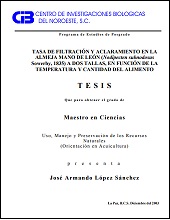| dc.contributor | ALFONSO NIVARDO MAEDA MARTINEZ | |
| dc.contributor | MARIA TERESA SICARD GONZALEZ | |
| dc.creator | JOSE ARMANDO LOPEZ SANCHEZ | |
| dc.date | 2003-12-12 | |
| dc.identifier | http://cibnor.repositorioinstitucional.mx/jspui/handle/1001/380 | |
| dc.identifier.uri | http://dspace.cibnor.mx:8080/handle/123456789/2597 | |
| dc.description | Se estudió la tasa de filtración (TF) y de aclaramiento (TA) en juveniles de 46.1 ± 2.2 y 65.1 ± 1.9 mm de altura de Nodipecten subnodosus expuesto a una combinación de siete tratamientos de concentración de la microalga Isochrysis galbana (entre 1.7 x 104 y 4.7 x 105 cél/mL), y tres temperaturas (19, 24 y 28 °C). Además se investigó la actividad alimenticia en almejas de mayor talla, a condiciones variables (24 ± 4 °C) y constantes (24 °C) de temperatura, determinándose si la especie era un filtrador continuo o discontinuo, y si existía un efecto de la iluminación (0 y 420 lx) sobre la TF. La TF fue similar a 24 y 28 °C pero más alta que a 19 °C (P>0.05), en las dos tallas y en todas las concentraciones probadas. La TF fue dependiente de la concentración de partículas entre 1.7 x 104 y 2.0 x 105 cel/mL, y posteriormente fue independiente a concentraciones mayores a las temperaturas y tallas investigadas. El punto de inflexión ocurrió a 4.5 x 106 y 2.1 x 106 cél/g/min en almejas de 46.1 ± 2.2 y 65.1 ± 1.9 mm respectivamente. La TA varió inversamente proporcional a la concentración de partículas. El rango óptimo de TA se obtuvo entre 1.7 x 104 y 8.0 x 104 cel/mL, alcanzando valores máximos de 3.8 y 1.6 L/g/h en almejas de 46.1 ± 2.2 y 65.1 ± 1.9 mm respectivamente. La eficiencia de retención fue de 80 - 90 % en almejas de 46.1 ± 2.2 y 65.1 ± 1.9 mm respectivamente a bajas concentraciones de partículas (0.17 x105 – 0.87 x 105 cél/mL), disminuyendo a 35 y 51 % a concentraciones mas altas (2.71 x 105 y 4.76 x 105 cél/mL). La actividad alimenticia de esta especie fue continua durante 75 horas a 24 °C de temperatura. Bajo condiciones fluctuantes de temperatura (24 ± 4 °C) la actividad alimenticia no tuvo una correlación con la temperatura ni tampoco entre repeticiones, pero sí con la frecuencia de fluctuación térmica. Además se observó que la TF de N. subnodosus se aclimató ante las condiciones fluctuantes de temperatura, observándose un periodo de inestabilidad de TF antes de las 35 y 45 h, seguido por un periodo de estabilidad. En el presente trabajo, la TF de almeja mano de león no fue afectada ante cambios alternados de iluminación. | |
| dc.description | The effect of seven concentrations of Isochrysis galbana between 1.7 x 104 and 4.7 x 105 cells/mL, and three temperatures (19, 24 y 28 °C) on filtration (TF) and clearance (TA) rates of Nodipecten subnodosus of two size classes (46.1 ± 2.2 and 65.1 ± 1.9 mm shell height) were investigated. In addition, it was determined the effect of high frequency (12 h) and low frequency (24 h) variable temperature regimes (24 ± 4 °C) vs. constant (24 °C) temperatures, and if this was a continuous rather than a discontinuous filter-feeder species. Finally, it was tested the effect of a 6 h-photoperiod light-darkness on TF, at 420 lx light intensity. TF was similar at 24 and 28 °C but higher at 19 °C (P>0.05), at the two size classes and in all concentration treatments tested. TF depended on particle concentrations within the range 1.7 x 104 - 2.0 x 105 cells/mL, and afterwards became independent at higher concentrations in all temperatures and size classes investigated. The inflexion point occurred at 4.5 x 106 and 2.1 x 106 cells/g/min in scallops of 46.1 ± 2.2 and 65.1 ± 1.9 mm respectively. TA varied inversely with particle concentration. The optimum range of TA was obtained between 1.7 x 104 and 8.0 x 104 cells/mL, reaching maximum values of 3.8 and 1.6 L/g/h in 46.1 ± 2.2 and 65.1 ± 1.9 mm scallops respectively. Retention efficiency (RE) was 80 and 90 % in 46.1 ± 2.2 and 65.1 ± 1.9 mm scallops at low particle concentrations (0.17 x105 – 0.87 x 105 cél/mL), but RE dropped at higher concentrations (2.71 x 105 and 4.76 x 105 cells/mL) to 35 and 51 %. The feeding activity of this species was continuous during a 75 h experiment at 24 °C. TF and TA did not correlated with temperature under the temperature-fluctuation experiments (24 ± 4 °C), although higher variations were observed in the high-frequency regime. In these experiments it was evident that N. subnodosus TF acclimated after 35 - 45 h of temperature fluctuations. Finally, TF was not affected by the photoperiod investigated. | |
| dc.format | application/pdf | |
| dc.language | spa | |
| dc.publisher | Centro de Investigaciones Biológicas del Noroeste, S.C. | |
| dc.rights | info:eu-repo/semantics/openAccess | |
| dc.rights | http://creativecommons.org/licenses/by-nc-nd/4.0 | |
| dc.subject | info:eu-repo/classification/AUTOR/Nodipecten subnodosus; tasa de filtración; tasa de aclaramiento; eficiencia de retención | |
| dc.subject | info:eu-repo/classification/cti/6 | |
| dc.subject | info:eu-repo/classification/cti/31 | |
| dc.subject | info:eu-repo/classification/cti/3104 | |
| dc.subject | info:eu-repo/classification/cti/310406 | |
| dc.subject | info:eu-repo/classification/cti/310406 | |
| dc.title | Tasas de filtración y aclaramiento en la almeja mano de león (Nodipecten subnodosus Sowerby, 1835) a dos tallas, en función de la temperatura y cantidad del alimento | |
| dc.type | info:eu-repo/semantics/masterThesis | |
| dc.type | info:eu-repo/semantics/publishedVersion | |


